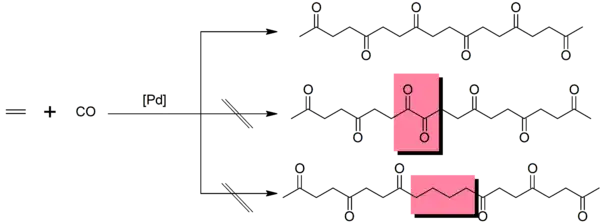Polyketone
Polyketones are a family of high-performance thermoplastic polymers. The polar ketone groups in the polymer backbone of these materials gives rise to a strong attraction between polymer chains, which increases the material's melting point (255 °C for copolymer (carbon monoxide ethylene), 220 °C for terpolymer (carbon monoxide, ethylene, propylene). Trade names include Poketone, Carilon, Karilon, Akrotek, and Schulaketon. Such materials also tend to resist solvents and have good mechanical properties. Unlike many other engineering plastics, aliphatic polyketones such as Shell Chemicals' Carilon are relatively easy to synthesize and can be derived from inexpensive monomers. Carilon is made with a palladium(II) catalyst from ethylene and carbon monoxide. A small fraction of the ethylene is generally replaced with propylene to reduce the melting point somewhat. Shell Chemical commercially launched Carilon thermoplastic polymer in the U.S. in 1996,[1] but discontinued it in 2000.[2] SRI International offers Carilon thermoplastic polymers.[3] Hyosung announced that they would launch production in 2015.[4] Hyosung Chemical Corp. is the only company who has been in commercial production and supply polyketone base(neat) polymer since 2015.

Industrial production
The ethylene-carbon monoxide co-polymer is most significant. Industrially, this polymer is synthesized either as a methanol slurry, or via a gas phase reaction with immobilized catalysts.[5][6]
Polymerization mechanism
Initiation and termination
Where external initiation is not employed for the methanol system, initiation can take place via methanolysis of the palladium(II) precursor, giving either a methoxide or a hydride complex. Termination occurs also by methanolysis. Depending on the end of the growing polymer chain, this results in either an ester or a ketone end group, and regenerating the palladium methoxide or hydride catalysts respectively.[7]
Propagation
A mechanism for the propagation of this reaction using a palladium(II)-phenanthroline catalyst has been proposed by Brookhart:[8]
Polyketones are noted for having extremely low defects (double ethylene insertions or double carbonyl insertions, in red):
The activation barrier to give double carbonyl insertions is very high, so it does not occur.[7] Brookhart's mechanistic studies show that the concentration of the alkyl-ethylene palladium complex required to give double ethylene insertions is very low at any one point:
Additionally, the Gibbs energy of activation of the alkyl-ethylene insertion is ~ 3 kcal/mol higher than the corresponding activation barrier for the alkyl-carbon monoxide insertion. As a result, defects occur at an extremely low rate (~ 1 part per million).[8] The industrially-relevant palladium-dppp catalyst has also been investigated.[9]
Importance of bidentate ligands
Where palladium(II) pre-catalysts bearing monodentate phosphine ligands are used in methanol, a relatively high fraction of methyl propionate is produced. In comparison, where chelating diphosphine ligands are used, this side-product is absent. This observation is rationalized: the bis(phosphine) complex can undergo cis-trans isomerization to give the sterically favored trans isomer. The propionyl ligand is now trans- to the open coordination site or ethylene ligand, and is unable to undergo migratory insertion. Instead, solvolysis by methanol occurs, which gives the undesired methyl propionate side-product.[7]
References
- Shell Chemical Company announces The U.S. commercial launch of CARILON Polymers
- MatWeb-Shell Carilon® DP P1000 Polyketone (discontinued **)
- Carilon Thermoplastic Polymer - Next-Generation Plastics from SRI International Archived 2011-01-10 at the Wayback Machine
- Vink, David (15 September 2014). "Finding openings for polyketone compounds". PlasticsNewsEurope. Archived from the original on 18 May 2015. Retrieved 12 May 2015.
- Drent, E.; Mul, W. P.; Smaardijk, A. A. (2001). "Polyketones". Encyclopedia Of Polymer Science and Technology. doi:10.1002/0471440264.pst273. ISBN 9781118633892.
- Bianchini, C (2002). "Alternating copolymerization of carbon monoxide and olefins by single-site metal catalysis". Coord. Chem. Rev. 225 (1–2): 35–66. doi:10.1016/S0010-8545(01)00405-2.
- Drent, Eite; Budzelaar, Peter H. M. (1996). "Palladium-Catalyzed Alternating Copolymerization of Alkenes and Carbon Monoxide". Chem. Rev. 96 (2): 663–682. doi:10.1021/cr940282j. PMID 11848769.
- Rix, Francis C.; Brookhart, Maurice; White, Peter S. (1996). "Mechanistic Studies of the Palladium(II)-Catalyzed Copolymerization of Ethylene with Carbon Monoxide". J. Am. Chem. Soc. 118 (20): 4746–4764. doi:10.1021/ja953276t.
- Shultz, C. Scott; Ledford, John; Desimone, Joseph M.; Brookhart, Maurice (2000). "Kinetic Studies of Migratory Insertion Reactions at the (1,3-Bis(diphenylphosphino)propane)Pd(II) Center and Their Relationship to the Alternating Copolymerization of Ethylene and Carbon Monoxide". J. Am. Chem. Soc. 122 (27): 6351–6356. doi:10.1021/ja994251n.


.png.webp)

